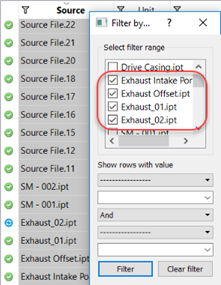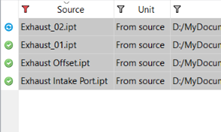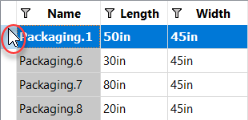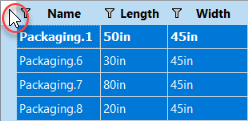Many dialog boxes in Inventor Nesting consist of tables you can use to manage and edit information in one location; for example, the Sources dialog box.

In these tables, you can edit, sort, import, export, and copy and paste data, as well as create and apply different views.
Show and Hide Columns and Edit Information
- To add columns to the list, right-click a column header and select Display Columns, then select which columns you want to show.
- To sort by property, click the appropriate column header.
- To move a column to the left or right, click and drag it to its new location.
- To filter the list, right-click a column header and set the filter values you want.
For example, in the Sources dialog box, to only show shapes related to certain source files, right-click the Source header, select "Filter By Source" and select the source files you want. When a column has a filter applied to it, the filter icon turns red
 .
.
Before Filter After Filter 

- To edit individual values in the table, make changes to them directly in the list. (Gray cells cannot be edited.)
- To duplicate, delete, or change the visibility of an item, right-click its row in the table and click
Duplicate,
Delete, or
Visibility.
Not all these options are available for every table in Inventor Nesting. When you duplicate an item, a copy is created in the table and its name is appended with "(Copy)".
Create and Apply Views
A view is a custom layout of the table that shows the columns and filters you want. Each table has a default view, and you can create your own.
To apply a view:
- Right-click in the table and select Apply View.
- Select the view you want.
To save a view:
- After making changes to a view, right-click inside the table and select Save View.
- Enter a name for the view.
Any view you create is stored on your workstation, so you can use it with any model you are working with. It is not stored with your nesting study, so if you open your Inventor Nesting file on another workstation, you will not have access to your custom view.
Edit Multiple Cells at Once (Multi Edit)
- Within a column, select the cells you want to change using Shift- or Ctrl-click.
- Right-click the selection.
- Select Multi Edit from the context menu.
- In the dialog box that opens, enter the new value for the cells.
Copy and Paste within the Table
- Right-click and select Copy or Paste, or;
- Press Ctrl-C or Ctrl-V
You can copy and paste one cell to another cell as you normally would, or paste values to multiple cells.
- Copy a cell; for example, a Width value in the Packaging dialog box.

- Select multiple target cells (using Shift- or Ctrl-click).

- Paste the copied value onto the selected cells.

To copy and paste a row to the whole table:
- Click the space to the left of the row to select it.

- Copy the row.
- Click the upper left corner of the table to select the full table as your paste destination.

- Paste the row.
The copied row is pasted to all rows in the table.
Import and Export Data
You can import and export all or parts of a table to comma-separated values (CSV) or eXtensible markup language (XML) files. This can be useful for:
- Using spreadsheets to calculate data; for example, you could create a spreadsheet of a series of materials that have the same density but with thicknesses that increment by 0.5 mm, then import this spreadsheet into Inventor Nesting.
- Creating process reports that can be shared with other engineers.
To export from the table:
- In the table, select the cells you want to export.
- Right-click the selection and select Export.
- Enter a file name and path for the export and click OK.
The appropriate data, including column headers, are exported to the file.
To import data to the table:
- Prepare the CSV or XML file that you want to import.
For example, you can make changes to a file you previously exported from the table, or you might have a spreadsheet that you created using data from your work environment. Make sure your column headers match those in the table, so that Inventor Nesting can place the data correctly. The order of columns does not matter, as long as the header names match.
- In the table, click anywhere in a row to designate that row as the start point for data import.
The cells you import will be inserted starting in this row, into the appropriate column headers.
- Right-click inside the table and select Import.
- Navigate to the file you want to import and click OK.
The file is imported and the appropriate cells are replaced starting at the row you selected. If the imported file has columns that are not present in the current table view, they are not imported.
